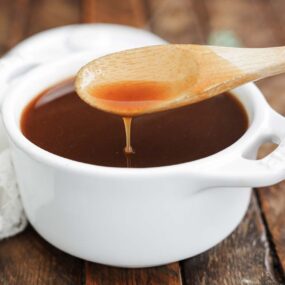

Glace De Viande
This homemade Glace de Viande transforms everyday dishes into gourmet meals with ease. As a profoundly flavorful and versatile reduction, just one spoonful elevates sauces, soups, gravies, and braised dishes with rich, concentrated depth.
Ingredients
- 8 pounds veal bones
- 2 roughly chopped yellow onions, weighing a total of 1 pound
- 2 roughly chopped ribs of celery, weighing a total of 8 ounces
- 2 peeled or unpeeled roughly chopped carrots, weight a total of 8 ounces
- 6 ounces tomato paste
- 1.5 cups dry red wine
- 2 to 3 sprigs of thyme
- 2 to 3 parsley stems
- 8 to 10 peppercorns
- 2 to 3 garlic cloves
Instructions
- Preheat the oven to 450°.
- Add the bones to a large roasting pan and place it in the oven in a middle rack and cook for 90 minutes.
- Remove the bones and add them to an extra-large stock pot. I used a 5 gallon pot.
- Cover the bones with about 1 1/2 gallons of cold water. The bones should be completely submerged under the water by about 2 inches. Simmer it over low to medium heat.
- Add the vegetables to the roasting pan and sauté in the rendered fat for 25 to 30 minutes over medium heat while frequently stirring with a spoon or until well caramelized. It’s ok to use two burners. Feel free to also place the pan on a middle rack in the oven at 450° for 25 to 30 minutes.
- Next, stir in the tomato paste and cook for 8 to 10 minutes to deepen the flavor and becomes a rust like color. Deglaze with the wine and cook for an additional 5 to 6 minutes or until it is reduced by one half.
- Pour everything into the stock pot along with the thyme, parsley, peppercorns, and garlic
- Simmer the stock over low to medium heat for 6 to 8 hours and be sure to come back every hour to skim and discard any impurities or fat that collects at the top.
- Strain the stock completely through a chinois, fine mesh strainer, or cheesecloth into a large pot.
- Return it to the burner and cook over low-to-low-medium heat until it is reduced by 80 percent. There should only be about 6 cups remaining.
- Store or use it.
Notes
I highly recommend checking if the Glace de Viande is properly reduced by dipping a spoon into it. The glaze should coat the back of the spoon evenly without running off too quickly.
Roasting: I always roast the bones at 450°F to build a deep, rich flavor base. Giving them the full 90 minutes ensures they caramelize properly.
Simmering: I never let the stock boil because it can turn cloudy and affect the final texture. Keeping it at a low simmer helps develop a thick, glossy glaze.
Skimming: I skim the stock every hour to remove impurities and excess fat. A ladle or fine-mesh skimmer makes this step quick and easy.
Straining: I always strain the stock through a fine-mesh strainer, chinois, or cheesecloth for a smooth, refined finish. This removes any leftover solids and gives the glaze a perfect consistency.
Storage: I store my glace de viande in small portions so I can easily use just what I need. It freezes well, making it easy to have on hand for future dishes.
Make-Ahead: If you’re serving it as part of a dish, the glace de viande can be kept warm on the stove over very low heat for a few hours. Stir it occasionally and avoid boiling it, as this can affect its smooth consistency.
How to Store: Once cooled to room temperature, transfer the glaze to an airtight container and store it in the refrigerator for up to 1 week. Alternatively, freeze it in small freezer-safe containers or ice cube trays for up to 6 months. When ready, let the individual portions thaw overnight in the fridge.
How to Reheat: The gelatin extracted from the bones makes this glaze gelatinous when chilled. This is completely normal and a sign of a well-made glace de viande! When reheated over low heat, it will return to its smooth, syrupy consistency. If it’s too thick, stir in a splash of water or stock to loosen it up.
Nutrition
Calories: 25kcalCarbohydrates: 3gProtein: 1gFat: 0.1gSaturated Fat: 0.02gPolyunsaturated Fat: 0.02gMonounsaturated Fat: 0.01gSodium: 63mgPotassium: 113mgFiber: 1gSugar: 2gVitamin A: 984IUVitamin C: 3mgCalcium: 9mgIron: 0.3mg